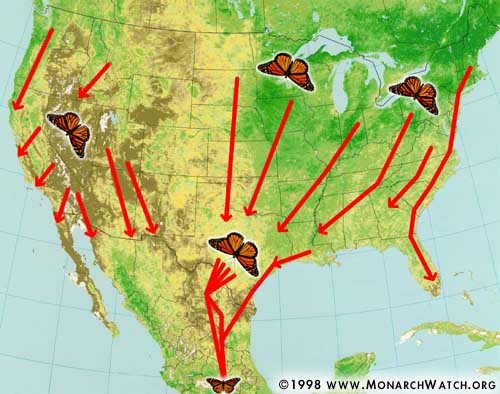
It’s Monarch Time in Cape May!
It is so exciting when it is Monarch time in Cape May! Seems like they are everywhere you look. I have always had a love affair with butterflies, so finding out that Cape May was on the migratory path was huge for me. Early Fall is just the time when those little cuties are passing through on their way down south for the winter. The fact that they travel up to 3,000 miles (according to National Geographic) during their migration is nothing short of a miracle! They often fly as far as 25-30 miles a day—just imagine how many tiny wing flaps that translates into!
Cape May plays a significant role in the eastern migration as it is directly on their route to central Mexico or the southern US from as far north as Maine. No other butterfly in world migrates like the Monarchs of North America. They often travel in masses and often roost in the exact same trees every year. Sadly, unlike many birds and whales that have a migratory habit, they only make the trip once. It is their children and grandchildren who will be the ones traveling in the coming years. Technically, there are four generations of Monarchs that are born each year as they make their way up the eastern part of the United States, which is why you can find Monarch chrysalis and adults in many different states. Monarch Joint Venture provides a great deal of very interesting information if you want to dive deep into the annual Monarch life cycle. There is way too much detail for me to go into it here…
So how do they do it? They primarily use a sun compass to navigate their way. However, some scientists believe that the Monarchs also us a magnetic compass to orient themselves. It is a sort of backup to the sun compass on cloudy or overcast days. The use of the magnetic compass relies on short wave UV-light. The adult butterfly’s antennae house a light-sensitive magneto sensor. Why knew they were such complex and mysterious little creatures?
The success of their long journey relies heavily on their ability to get enough to eat and store fat in their abdomen for fuel. They also need that fat to overwinter, as they eat very little or not at all during that time. Adult Monarchs must consume a great deal of nectar from a wide variety of flowers such as asters, goldenrod, liatris and more. However, milkweed is absolutely critical to Monarch butterflies. The adult Monarchs sip the nectar and then lay their eggs amongst the leave. The Monarch caterpillars then eat the milkweed leave to grow. The average Monarch caterpillar can eat over 20 milkweed leaves in its lifetime. In my post, Railbiking in Cape May-Try It!, I mention the Garrett Family Preserve (it is a stop on the return leg of the trip). The meadows are planted specifically with birds, bees, and Monarch butterflies in mind. So if you visit, you will see milkweed and other flowering plants the help the little ones on their journey. Speaking of little, fun fact—did you know a Monarch butterfly weighs less that a paperclip?
Back to Cape May and the part it plays in the migration (actually, I learned that it is technically called emigration because of the one-way aspect as described above, but I digress). The New Jersey Audubon Monarch Monitoring Project is amazing. Established over 30 years ago in 1990, the project gathers data on Monarchs traveling through Cape May during September and October. The project hold Tagging Demo events free of charge (donations welcome) at Cape May Point State Park in September. The team gives a talk about the project and then small tags are affixed to the Monarchs to track their migration. Seriously—how cool is that? To learn all about those events (as well as birding and such), check out their calendar here. If you really want to stay in the know about all their Monarch happenings, check out their Facebook page. If you would like to really get involved, you can adopt a Monarch butterfly. Yes, you did read that correctly and you can do it here.
So if you are new to Cape May and you were wondering about the Monarch mural behind Pink by Victorious shop (the big pink house on Perry Street)—now you know the significance! So many people have snapped a picture for Insta or Facebook in front of that mural. I wonder how many of them know why it is there and when it is Monarch time in Cape May… Share this post with anyone you know who has a picture of themselves as a Monarch or anyone who loves Cape May for that matter.
I really started to geek out on Monarch butterflies while researching this post. Is your curiosity to learn more peaked too? Unraveling the Great Butterfly Migration Mystery is an excellent video to watch. If you want to see where most of the Monarchs end up and winter over before they fly north, I recommend The SOUND of Millions of Monarch Butterflies!
Please remember—subscribe if you haven’t done so already. It is the best way to stay connected and on top of new posts. I love welcoming more and more folks to my growing community!







